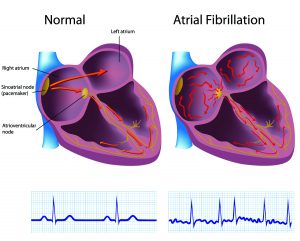Heart matters
Atrial fibrillation is a common heart rhythm disorder affecting millions around the world.
 Atrial fibrillation (AF) is the most common heart rhythm disorder affecting many globally. The condition, where patients experience rapid and irregular heartbeat, deteriorates with age and is common amongst those over the age of 65.
Atrial fibrillation (AF) is the most common heart rhythm disorder affecting many globally. The condition, where patients experience rapid and irregular heartbeat, deteriorates with age and is common amongst those over the age of 65.
Ageless Online finds out more about this disorder from Dr Kelvin Wong, a consultant cardiologist and a speaker at the atrial fibrillation public forum in July, organised by by the Singapore Heart Foundation (SHF), Asia Pacific Heart Rhythm Society (APHRS) and Singapore Cardiac Society (see details below):
What is atrial fibrillation (AF)?
AF is a heart rhythm disorder involving the upper chambers of the heart (“atria”) which quiver (“fibrillation”) rather than contract in a synchronised fashion. It is characterised by an irregular heart rhythm which is usually fast.
How many people in Singapore have AF, who are over 65?
In a small study screening 1,839 Chinese over the age of 55 in the southeast region of Singapore, the prevalence in Singapore was estimated to be 1.5 percent, increasing to 5.8 percent in individuals over the age of 80. This is in line with a prevalence of 1.6 to 3.5 percent in elderly Asian populations including China, Taiwan, Japan and Korea, compared to five to right percent in the Western populations. This is likely to be an underestimate.
I understand episodes of AF can come and go, or one can develop AF where it doesn’t go away and will need treatment. Where do most people in Singapore lean towards?
It is widely believed that AF is a progressive condition, starting with episodic occurrences (paroxysmal) before becoming persistent. Individuals can have paroxysmal or persistent atrial fibrillation, though the latter may be more easily diagnosed.
I understand AF is usually not life-threatening. What is the cause of AF?
While AF is not life-threatening in itself, it is often associated with worse outcomes including strokes, heart failure, recurrent hospitalisations, etc. The cause of AF is often multi-factorial. It is commonly associated with other cardiac conditions (e.g. valvular heart disease, coronary artery disease, weak heart, high blood pressure, etc), other medical conditions (e.g. thyroid disease, diabetes mellitus, obstructive sleep apnoea, etc), obesity, excessive alcohol intake, or simply as a result of ageing. In some cases, there is no obvious cause found and is termed “lone AF”.
What are the signs and symptoms of AF? Risk factors?
People may just be aware of fast and/or irregular heartbeats. Some may experience chest pain, shortness of breath, tiredness, reduced exercise capacity and dizziness secondary to slightly less efficient hearts due to the lack of coordinated contractions of the upper chambers (atria). Others may have no symptoms at all. Significant chest pain, shortness of breath and dizziness should be warning signs to seek prompt medical attention.
Why should those over 65 be concerned of AF? What could AF lead to in terms of complications?
AF is associated with a higher risk of strokes. In fact, stroke can be the first presentation of previously undiagnosed AF. AF can also lead to weak hearts and heart failure, resulting in fluid retention in the legs or lungs.
When should a person see a doctor? What would the doctor likely do to diagnose the condition?
One should seek medical attention if they are aware of abnormal heartbeats or any of the above symptoms associated with AF, especially the warning signs. As AF may be asymptomatic, it may be worthwhile to get checked on a regular basis.
The doctors will usually perform a simple examination and order tests like “electrical tracing of the heart” (electrocardiograph (ECG)), an ultrasound scan of the heart (echocardiogram (ECHO)) and basic blood tests. Occasionally, doctors may request for patients to wear a heart recorder to monitor the heart rhythm.
How can people prevent AF?
While there is a lack of strong, robust evidence for AF prevention, emerging data are pointing to the value of controlling certain risk factors to prevent AF. Moderate exercise, avoiding obesity, avoiding excessive alcohol intake, and stopping smoking have all been shown to be beneficial. Treating certain medical conditions such as blood pressure, diabetes mellitus and obstructive sleep apnoea will also help to reduce the incidences of AF.
And if someone has AF, what are the available treatments?
In general, the strategy to treat AF is two-fold – treat the symptoms and to reduce the risk of strokes. Treating the symptoms may involve using medications to slow down the heart rate, sometimes with the implantation of a pacemaker. It may also involve using stronger medications to help control the heart rhythm, an “electrical shock” (cardioversion) to restore normal rhythm or even a percutaneous procedure to abolish the “electrical short circuits” that result in AF (catheter ablation). To reduce stroke risk, medications to “thin” the blood may be recommended. There is also growing evidence that certain devices placed in the heart may reduce stroke risk in selected patients.
How is atrial flutter different from atrial fibrillation?
Atrial flutter and Atrial fibrillation are closely related and often come hand-in-hand. In general, atrial flutter is a result of a single “electrical short-circuit”, while atrial fibrillation represents more chaotic electrical activity. Nonetheless, the impact of atrial flutter and atrial fibrillation is similar and the treatment options are also the same.
Can you share one or two interesting patient stories on AF?
Unfortunately, I have a sad story but one that I hope will have a learning point. I diagnosed atrial fibrillation in a patient whom I strongly recommended “blood thinning” medication to reduce stroke risk. However, she was not keen and was concerned about the cost and inconvenience of taking the medication. Unfortunately, she was admitted with a stroke six months later.
In another patient, he was admitted with atrial flutter resulting in weak heart and heart failure. There was water retention in the lungs. Despite attempting to control the heart rhythm with medication and “electrical shock”, the atrial flutter recurred. We then performed a successful catheter ablation and he has been well since.
| SIDEBOX: Atrial Fibrillation Month 2016: Atrial Fibrillation Matters Public Forum
Atrial fibrillation (irregular heartbeat) (AF) Matters Public Forum is organised by the Singapore Heart Foundation (SHF), Asia Pacific Heart Rhythm Society (APHRS) and Singapore Cardiac Society on July 2 (Saturday) from 9am to 10.45am at The Joyden Hall, 201 Victoria St, #07-01, Bugis+. To raise awareness of the condition on Atrial Fibrillation Month, SHF is hosting a one-day public forum. Experts will weigh in on the condition, the risk factors, symptoms, related complications and prevention measures. There are two sessions, including in English. The topics for each session are:
Book tickets now and receive a welcome gift worth $65 (CPR 3A Kit)! Tickets can be purchased on SISTIC via this link. The fee is $15 (now to July 1) or $20 (walk-in on July 2) (* amounts excludes $1 SISTIC booking fee). For more information, go to www.myheart.org.sg. |
(** PHOTO CREDITS: Singapore Heart Foundation)


0 Comments